MARIANI’S
June 5, 2005
NEWSLETTER
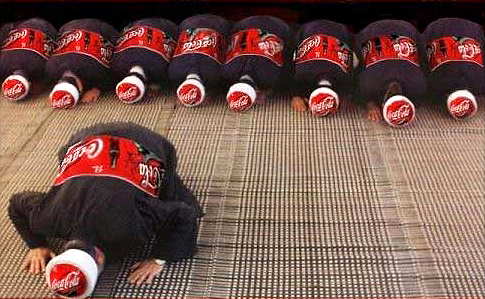
UPDATE:
To
go to my web site, in which I will update food
&
travel information and help link readers to other first-rate travel
& food sites, click on: home page
ACCESS TO
ARCHIVE: Readers may now access
an
Archive of all past newsletters--each annotated--dating back to July,
2003, by simply clicking on www.johnmariani.com/archive
.
NEW
FEATURE! You may now subscribe anyone you wish
to this newsletter by
clicking here.
~~~~~~~~~~~~~~~~~~~~~~~~~~~
FINDING BERGAMO by
John Mariani
NEW YORK CORNER:
HAKUBAI by John Mariani
NOTES FROM THE WINE CELLAR:
NY VS TX
by Mort Hochstein
QUICK
BYTES
~~~~~~~~~~~~~~~~~~~~~~~~~~~~
Finding
Bergamo
by John Mariani
Photos by Galina
Stepanoff-Dargery
I can't say I
knew much about Bergamo before visiting this large walled city in
Lombardy. It lies along the usual tourist route for those
visiting Italy's northern lake country, and it is just off the A4
between
Milan and Verona. Still, it's not in the category of must-see cities
like Florence, Rome, and Venice, so it is often bypassed by Americans;
Europeans, however, have found it easily accessible and flock to it for
its myriad pleasures, which have somehow been maintained despite a
millennium of various domineering rulers and nations that took their
toll on the city, until Garibaldi
liberated Bergamo from the Austrians in 1859.
The outskirts of the city offer little
to draw the eye, and we stayed at a boring but efficient modern
business hotel just over the bridge, Una
Hotel Bergamo (154 Via Borgo
Palazzo; 035-308-111), strikingly ugly in total contrast
to the antique beauty of the city five miles away, but
serviceable at about $110 per night.
The lower, newer part of Bergamo is fairly
nondescript except for the Carrara Academy, whose collection
includes an array of Renaissance masters like Tintoretto, Bellini,
Lotto, and Titian, and for the broad Piazza Matteotti that leads to the
upper part of the city, which you enter through 16th-century Venetian
portals. Take
the funicular up to
the old town or park your car wherever you can, then walk straight into
the
heart of Bergamo, up steep, shiny cobblestone streets to the Piazza del
Duomo, which is as splendidly sized as any in northern Italy, not
grandiose but human in scale. Equally beautiful is the Piazza
Vecchia (above), with its
12th-century bell tower and graceful fountain. Beyond these there
are
winding narrow pathways teeming more with locals than with tourists,
and the farther you get from the center, the quieter the city becomes
behind its ancient
walls.
Bergamo, not Venice, is the birthplace of the commedia dell'arte,
so the shops have a good selection of masks
to buy. But this is not a highly dramatic city; instead, it has a
dearness in its close quarters and streets, which are all scrubbed
clean; the many shops, pasticcerias, and food stores burst with color. With so many cultural influences
determining their city's
fate over the centuries, the Bergamasks are sophisticated but not
overly effusive and strike a distinct northern reserve. But teenagers, like their contemporaries
everywhere, bound
from one side of the street to the other, singing pop songs, finding
their friends, and skidding past their elders, who walk with a
gait that is not frail but deliberate and slow, so as to take in a good
day's sunshine, the purple twilight of an evening, the starry skies at
night. Around the Piazza Vecchia everyone
flocks to the fountain, and visitors stroll to the Basilica
of Santa Maria Maggiore. This is the center of Bergamask life,
never frantic, ever sweet.
For those who wish to dine at the highest
level of Bergamask gastronomy, one restaurant has risen quite beyond
its humble name, Taverna Colleoni
dell'Angelo (7 Piazza Vecchia;
035-232-596). Set just to the side of the Piazza Vecchio, it is a
large
18-year-old restaurant with a comfortable formality inside, tuxedo-clad
waiters, and an unpretentious gentility that makes lingering here a
great luxury. There are many outdoor tables (right) where you may watch the passeggiata of Bergamo life in the
Piazza.
Taverna Colleoni respects
Lombardian culinary traditions while bringing them to a level of
refinement just
below the point where Italian might be stretched into something
else. Here the food is not so much simple as it is wholly thought
through for maximum flavor and just enough prettiness to make you sigh
and wonder how the Italians do it with what seems like so little effort.
The wine list is exceptionally
good, worldwide in its scope, including American labels like Atlas
Peak, Opus One, and Rubicon; the tablecloths are a heavy azure damask,
set with lace doilies, silverware with heft, thin glassware, and fresh
flowers.
We began our meal with an amuse of marinated salmon on greens
and radicchio, while we sipped a glass of sparkling prosecco. We
followed that with a 2000 Rosso dei Frati Priori with no more pedigree
than "vino da tavola," yet it
was
delicious, peppery, and quite tannic. Our antipasto was a plate of large
shrimp, calamari, and lentils scented with rosemary, followed by
two lovely pastas--trofie
(tiny squiggly dumplings) with stewed tomatoes and taleggio
cheese, and tajarin
(the Lombardian name for tagliatelle)
with porcini mushrooms,
cream, and an unexpected spoonful or two of blueberries that worked
well. Next came perfectly cooked monkfish with the curious
addition of a lemon grass stalk that gave piquancy to a dressing of
tomato and zucchini. A flavorful, tender veal medallion came with a
mushroom sauce and creamy yellow polenta.
There's an excellent variety of cheeses, many
Lombardian, including sweet Gorgonzola, which we savored
with the last of the wine, then we treated ourselves to a slice of rich
savarin cake capped with spun sugar and a perfect espresso. By then it
was getting late , but children still ran free in the Piazza, until, at
the stroke of ten o'clock, Duomo bell chimed 100 times to call
everyone home. The piazza grew quiet by the time the bell tolled
its last.
The bill, in these hard times for the American
dollar, came to 167 euros ($210), which included the antipasto, pastas
at 14 euros each ($17.60), main courses at 18 euros ($22.50), the wine
at 30 euros ($38), tax and service. As usual in Italy, there is a
coperto (cover charge),
here somewhat higher than I'm used to at 6 euros each ($7.50).
Good thing we dined on damask.
T he next day we
strolled for the entire morning through the old town, up the
mansion-flanked Via Bartolomeo Colleoni and around the still solid
fortress, past windows piled high with bread and pastries, pizza and
focaccia. We passed numerous trattorie, at a loss to decide
which one to enter, until we saw the sweet facade (left) of Vineria Cozzi (22 Via B. Colleoni), which
immediately won our hearts. Inside is a bustling wine bar and to
the rear two small dining rooms, with red-and-white diamond-patterned
floor tiles, bent metal chairs, a walls of yellow-ochre banded with
green wainscoting, one hung with an enchanting cherub (below) who watches over you while
you dine. In the background Alicia Keyes' CD was crooning
softly.
We were starving that day after all our
walking, so we
tore into the antipasti,
which included an array of salume,
cheeses, and breads.
Our pastas were cansonsei,
which means "little
britches," twisted like candy wrappers containing cheese, sausage bits,
and sage, in a rich sauce of butter and Parmigiano, and plump
ravioli with smoked cheese on a bed of spinach, braised fennel, pignoli
and sweet raisins. Then came a very good confit of duck with
roast potatoes, grapes, and prunes; disappointing, however, was a plate
of roast rabbit whose meat was dry, its polenta insipid.
Full with wine and food, we lingered over coffee, waiting to see who
else would come through the door of this ebullient little trattoria.
With a bottle of sturdy Valtellina wine, our bill
came to only $95, including, as always, tax and service. The
wine bar up front is where you may sample and sip and pay very little
for a fine casual lunch.
The
joy in coming upon a city like
Bergamo derives from nearly missing it along the route then
finding yourself enchanted by its quiet beauty and the sweetest form of
serendipity. She
has waited for you for centuries, and now you'll never forget her.
NEW
YORK CORNER
HAKUBAI
The Kitano Hotel
66 Park Avenue at East
38th Street
212-885-7000
www.kitano.com
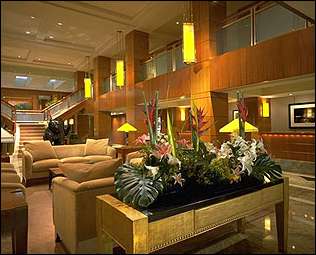 The
cliché about Japanese design and dining--"serenity"--might well
be
inappropriate to describe the frenetic eating scene in Tokyo's
Ginza district, but it most certainly applies to the tatami rooms and
kaiseki dinners held at restaurants throughout that food-mad
city. In NYC this might best be appreciated in the quiet and
genteel atmosphere of Hakubai
in the Kitano Hotel on Park Avenue, which seems just
slightly and safely distant from the hurly-burly of midtown hotels to
the north, east, and west of it. Formerly the Rockefeller-owned
Murray Hill Hotel, it's been in the Kitano orbit since 1973 and fitted
out with a splendidly spacious lobby (left)
and fine artwork that includes photography of New York, a huge
Fernando Botero bronze entitled "Dog" everyone wants to touch,
and four works by Red Grooms in the Garden Cafe restaurant on the
main level. Upstairs is a swank lounge.
The
cliché about Japanese design and dining--"serenity"--might well
be
inappropriate to describe the frenetic eating scene in Tokyo's
Ginza district, but it most certainly applies to the tatami rooms and
kaiseki dinners held at restaurants throughout that food-mad
city. In NYC this might best be appreciated in the quiet and
genteel atmosphere of Hakubai
in the Kitano Hotel on Park Avenue, which seems just
slightly and safely distant from the hurly-burly of midtown hotels to
the north, east, and west of it. Formerly the Rockefeller-owned
Murray Hill Hotel, it's been in the Kitano orbit since 1973 and fitted
out with a splendidly spacious lobby (left)
and fine artwork that includes photography of New York, a huge
Fernando Botero bronze entitled "Dog" everyone wants to touch,
and four works by Red Grooms in the Garden Cafe restaurant on the
main level. Upstairs is a swank lounge.
The showcase
restaurant here, however, is downstairs, leading to a foyer and into a
spare dining room with 84 seats, flanked by three tatami rooms, where
the multi-course kaiseki dinners are featured and spread over a
leisurely evening ($80-$150 per person). You sit at
the traditional low table-- legs comfortably allowed to dangle--and are
served an array of
dishes chosen by
the chef and brought by a kimono-dressed waitress with a dexterity in
bending, kneeling and placing of dishes that is as
unobtrusive as it is charming.
A kaiseki dinner begins with an
array of appetizers, each carefully conceived and part of the
decoration in color and symmetry. Executive chef Yukihiro Sato,
who has long worked for Kitano properties and at Hakubai for ten
years now, is a master of the kaiseki tradition, which dates
back more than 500 years in Japanese culinary history. The word
"omekase" means "Put your
trust in me," and, for $150 per person, Sato
will do everything to show off his innovative and traditional sides.
On a recent evening in a tatami room
here, (right) my wife and I
were served in the organized ritual of kaiseki, beginning with
housemade sesame-laced tofu, which had a cooling, lulling effect on the
palate. Next came real spark, in aloe with Japanese lime vinegar, then
saline brineyness with marinated mackerel pike.
Eel
sushi followed, fat and luscious in its purity of flavor, and then a
soothing dish of simmered spinach and matsutake mushrooms. A tender
shrimp cake was sandwiched between tempura-fried matsutake mushrooms,
then, when our appetites were at their peak, came fried shrimp rolled
in shiso leaf, and a rich loin of duck with yam stems, and, finally,
grilled dry sardine with the sauce of an egg yolk.
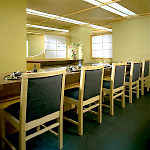 On another evening we went to the main dining
room (left) and ordered from
all over the menu's categories--grilled silver cod with soy bean paste,
a custard full of crab with shark's fin sauce, an excellent assortment
of sushi and sashimi, and Kobe-style beef shabu shabu which is seared
with a sizzle on a hot rock at the table (below).
On another evening we went to the main dining
room (left) and ordered from
all over the menu's categories--grilled silver cod with soy bean paste,
a custard full of crab with shark's fin sauce, an excellent assortment
of sushi and sashimi, and Kobe-style beef shabu shabu which is seared
with a sizzle on a hot rock at the table (below).
One of the best things about dining at
Hakubai are the numerous options at every price level. There is a
business lunch at $24, bento box lunches at $36, $55, and
$65, and a 4-course light ladies' lunch at $32. The selection of
sakes is impressive.
After
dinner one of the best ideas for a night on the town is to head
upstairs to the bar-lounge to listen to a continuing series of
classic and modern jazz musicians. And if further night wandering
is not in the cards, you may then retire upstairs to a room at the
Kitano and wake the next morning in peace and quiet, with only the rush
of Park Avenue below to stir you.
NOTES FROM THE WINE CELLAR
NEW YORK VERSUS TEXAS by
Mort Hochstein
The Texans lost because one of their gang did not come up with the top rated and most expensive wines that everyone else entered in the competition. The wine that won was a 1988 La Mouline, submitted by Larry Fink, CEO of the
It might actually have cost Fink (on paper) $1,300, because each entrant supplied two bottles. The winning bottle carried a 100-point rating from wine guru Robert M. Parker, whose advice guided most of the contestants. “I knew my La Mouline would kick butt,” Fink exulted afterward.
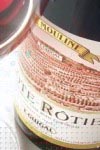 The
second place wine was an ’83 La Mouline entered by former computer
software
entrepreneur Ross Garber of the
The
second place wine was an ’83 La Mouline entered by former computer
software
entrepreneur Ross Garber of the But then there was a ’90 La Chapelle Hermitage entered by
“Still,” he said afterward, “it cost me less to lose than some of these guys paid for their wines,” a statement not altogether accurate. But it is likely that one or more of the contestants, lacking a strong
Another Texan, venture capitalist Bill Wood, arrived in
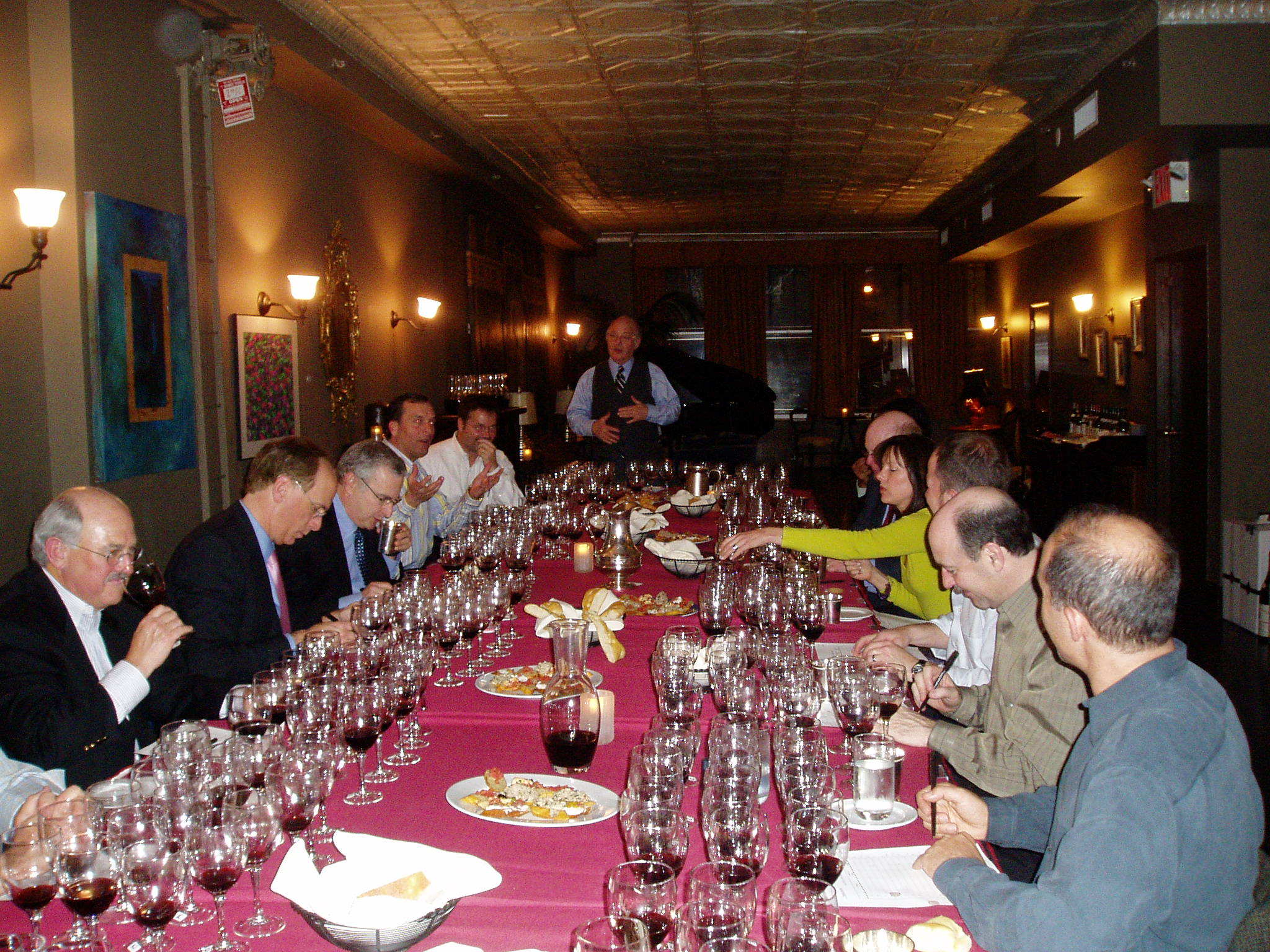
Despite the high stakes battle, there was none of the hushed decorum of normal wine tastings. Instead there were outbursts, nasty comments about the wines being tasted blind, a real no-no in the serious wine world, more than a few off-color jokes, and advice on buying wine. That came most notably from
Ann Colgin, producer of the cult wine Colgin California Cabernet Sauvignon, came away as the best of the tasters, ranking the entries closest to the final results. Colgin, whose ’81 Chave Hermitage finished 11th, will host the rematch, in answer to Lance’s plea for a chance to get even “as soon as possible.” That will probably be in November at Colgin’s
After the competition, the winners continued having fun at the expense of the losers at dinner. But the Yankees sweetened the evening with more Hermitage supplied by Conklin, and a Château d‘Yquem from BlackRock executive Rob Kapito. The value of the wines that flowed freely over the table in both parts of the evening was estimated at a little more than $20,000. It was just another night on the town, ending with an early morning return to
FOOD
WRITING 101: Try to
keep goofy metaphors to a minimum, especially in your first paragraph.
"Like many
an Oprah's book
club selection or a typical Best Picture nominee, BLT Fish affirms the
enormous appeal of the middlebrow, the special spark when high tips its
hat to low, refinement links arms with accessibility and art consorts
with commerce. If Le Bernardin took Bubba Gump's Shrimp Company as an
illicit amour, the precocious, spirited love child might look like
this. . . . It has the flexibility of a yogi master, the balance of a
Romanian gymnast. And it clinches the verdict: Laurent Tourondel is
back in the swim."--Frank Bruni, "Elevator to the Ocean," New York Times (April 20, 2005).
affirms the
enormous appeal of the middlebrow, the special spark when high tips its
hat to low, refinement links arms with accessibility and art consorts
with commerce. If Le Bernardin took Bubba Gump's Shrimp Company as an
illicit amour, the precocious, spirited love child might look like
this. . . . It has the flexibility of a yogi master, the balance of a
Romanian gymnast. And it clinches the verdict: Laurent Tourondel is
back in the swim."--Frank Bruni, "Elevator to the Ocean," New York Times (April 20, 2005).

TRUE, BUT HE DID GET RID OF THE BUGS
PLAN B: ELIMINATE GARY WILSON'S YEAR-END BONUS

Northwest Airlines has just announced it will eliminate serving bags of little pretzels on its flight in order to save $2 million a year.
Northwest Airlines Pres. and CEO Gary Wilson
DEPARTMENT OF CORRECTIONS

In response to my mention in last week's newsletter that the Russian Czars ate their beluga caviar from a silver spoon, eagle-eyed reader Henry Togna noted correctly that they more probably ate it from a bone or mother of pearl spoon.
QUICK BYTES
* On June 14 at Nolita House in NYC winemaker and teacher Clark Smith of WineSmith & CheapSkate Wines will lead a “Wine and Music Lab,” with 7 wines and tapas. $50 pp. Call 212-625-1712.
* On June 8 Women for WineSense and the Manhattan Chamber of Commerce are sponsoring a "Perfect Summer Wine Tasting" led by Eric Asimov, chief wine critic of the New York Times at Club 101. WWS Members: $50 pp in advance; $55 At The Door; Non-members: $60 pp and $65. Call 212- 473-7805 or e-mail events@manhattancc.org
* Lajitas Resort in
MARIANI'S VIRTUAL GOURMET NEWSLETTER is published weekly. Editor/Publisher:
John Mariani. Contributing Writers: Robert Mariani, Naomi
Kooker, Kirsten Skogerson, Edward Brivio, Mort
Hochstein, Lucy Gordan, Suzanne Wright. Contributing
Photographers: Galina Stepanoff-Dargery, Bobby Pirillo. Technical
Advisor: Gerry McLoughlin.
Any of John Mariani's books below
may be ordered from amazon.com by clicking on the cover image.
 |
 |
 |
 |
 |
 |
copyright John Mariani 2005